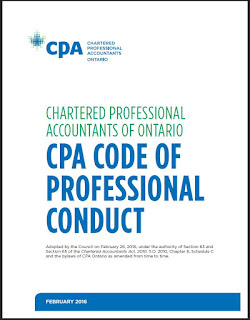In a June
2016 communication, the executive of the Chartered Professional Accountants
of Ontario (CPAs) stated that: “As CPAs, we hold ourselves to a high
standard in everything we do. We conduct ourselves at all times according to
the shared values and ideals of our profession, regardless of position, sector
or tenure, and we commit to our profession 24 hours a day, seven days a week.
That’s why I am pleased to inform you of a new CPA Code of Professional Conduct
that was recently approved by CPA Ontario’s Council and is now in effect. It
will be presented to members for ratification at the next Annual General
Meeting in September 2016."
"While most
members will not be impacted, the new CPA Code recognizes that our membership
provides professional services beyond public accounting. Members providing
these services may note a number of changes, such as in the Rules that govern
relationships amongst professional colleagues and in Rule 210 Conflicts of
Interest, as well as greater guidance provided to clarify common areas of
confusion."
"As CPAs, we
share common interests, ethics and concerns; now, we share a common philosophy,
principles and, indeed, rules of the profession. The inclusion of all
professional accountants under a common code — one that reflects the most
stringent requirements of the legacy bodies — is one of the benefits of unification."
"Though the
CPA Code is built upon foundational pillars — the fundamental principles of
professional behaviour, integrity and due care, objectivity, professional competence
and confidentiality — the whole is greater than the sum of its parts. Our
commitment to its principles is not situational; it does not stop at the end of
the working day. In short, as CPAs, we live our lives according to our personal
values and professional code — the CPA Code of Professional Conduct. Its
purpose is clear, its principles timeless, and its vision defines us not only
as a profession but as a community."
For an
overview of the new CPA Code, refer to the article, A
New Code of Professional Conduct, on page 8 of the Spring 2016 issue of
the publication Discussion and Analysis,
available online.


